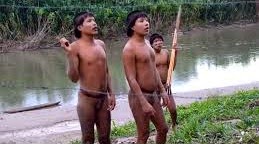Behind this striking appearance of youthful Xatanawa warriors on the Envira river in Acre, emerging from isolation to seek assistance from indigenous neighbors, lies a terrible history of massacres at the hands of 21st century drug traffickers and loggers and 19th century rubber tappers.
The "contact" of the Txapanawa[1] is an extraordinary story of resistance.
 |
| Video still of dramatic footage released by FUNAI showing Xatanawa contact. |
And yet mainstream reporting has emphasized sensational and exotic details, colonial ideas about a primitive people "emerging from the forest" and entering into "first contact" with civilization. Public comments express surprise at these "Stone Age" people carrying machetes, or even a shotgun. These ethnocentric perspectives ignore the deep and tragic history of this people, and others like them, while also overlooking the negligence of the Peruvian and Brazilian authorities in failing to guarantee their territorial and human rights.
CONTINUE READING the full article (in Portuguese) by Felipe Milanez and Glenn Shepard at Carta Capital
Also read the three-part series (in English) at Indian Country Today:
Part 1: Drug traffickers force isolated group into contact
Part 2: Banana diplomacy
Part 3: Quiet war in the Amazon
Read more from this blog on the history and origins of isolated indigenous peoples and the dilemmas of isolation and contact
[1]. Note: original reports suggested these people were known as the Xatanawa, close relatives of the Chitonahua of Peru. However more conversations with the group carried out by FUNAI through translators suggest they belong to a distinctive group speaking a language with important dialect variations, and that their name should be rendered as Txapanawa (J.C. Meirelles, personal communication).





